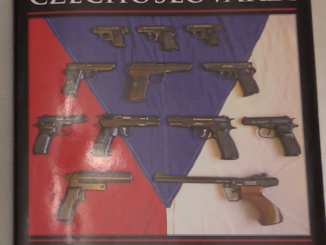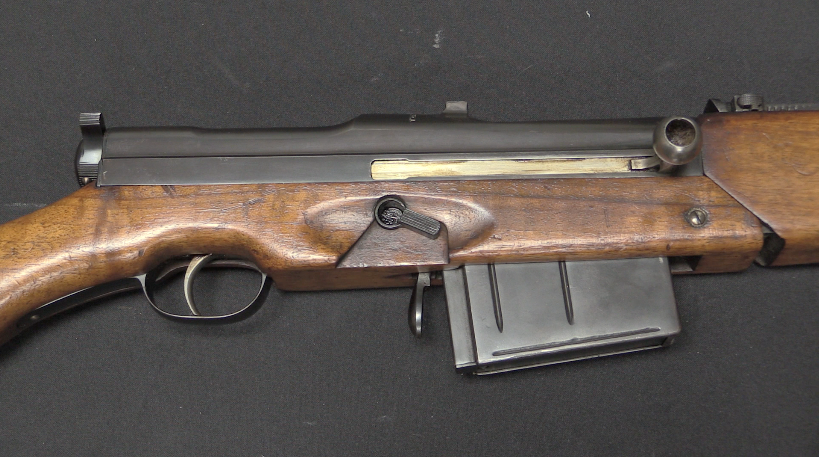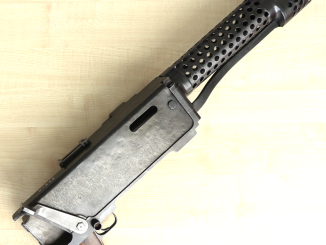The vz.82 and its cousin the CZ 83 are pistols that originated when the Czech state export company during the Cold War began looking for arms it could export to bring in hard currency. The current service pistol, the vz.52, was, shall we say, not widely desirable and its 7.62x25mm cartridge was not widely used outside the Warsaw Pact anyway. The earlier vz.50 and vz.70 pistols were also not really suitable, as they were old and rather clunky designs. Something new was needed that could appeal to customers worldwide.
So, the export firm approaches the state arms factory – CZ – about designing something new. The Ministry of Defense got wind of the project in 1977, and joined in – they also wanted a new pistol – specifically something in 9x18mm Makarov. In 1978 the Czech Ministry of the Interior also joins in, looking for a new pistol for the police. To meet all of these requests, CZ developed a remarkably modern and effective compact pistol which would eventually be made in three different calibers – .32 ACP, .380 ACP, and 9x18mm Makarov.
The first prototypes were completed in 1979, and full scale production began in 1982. Today we are looking at specifically a very early prototype vz.82 in 9x18mm (with a decocking mechanism that would later be dropped from the design) and the standard production vz.82.
The 9x18mm pistols were designated vz.82, and they used polygonal rifling because they were initially developed for a unique Czech 9x18mm cartridge which used a sintered iron bullet. That would cause undue wear on traditional rifling, and so polygonal rifling was chosen instead. The cartridge was eventually scrapped, but the rifling choice remained. The guns in .32 and .380 were designated the CZ 83, and used traditional rifling. Large numbers of both have come into the US in recent years as surplus.




I dunno why I’m getting a huge Browning Double Action .380 vibe off of these, but… I am.
Interesting confluence of ideas, between FN, Beretta, and CZ. Those suckers could damn well be long-lost brothers.
“(…)Interesting confluence of ideas, between FN(…)CZ.(…)”
Could not that simply by explaining by need to appeal to same potential customer?
Why is the next video about the vz.82 at the BUG match private and unwatchable?
vz. 82 http://www.vhu.cz/armadni-pistole-vz-82/ has 3 designers:
– Augustin Nečas (1918–1989)
– ing. Karel Strouhal
– Stanislav Střižík
they managed to get few autorské osvědčení for their developments, first of them earlier designed ZKR 590 Grand and various prototypes of sporting self-loading pistol – this might explain why vz. 82 has good ergonomics.
vz. 82 was designed to able to fire not less than 5000 shots. This was great progress compared to older vz. 52 which was rated for 2000 shots and in reality even after half of this visible damage to parts appeared and 2001th and next shots have high chance of causing failure.
Good info, thanks.
Those excellent ergonomics come at a cost, which explains the initial expensiveness. Here’s the disassembly of the frame:
https://www.youtube.com/watch?v=Yv31Mr1XLsE
It’s almost as if the designers said: “Comrade Machinists need all the work they can get.” The innards are a nightmare of 40+ interlinking parts, sometimes two or three held with the same pin, very clever in the way they interact, not unlike a C96 or even a Makarov, and resulting in a great feel, not unlike driving a Jaguar or Mercedes, with the same maintenance risks. Woe unto you who have a slide lock spring or sear spring fail — a major excavating project will follow.
There is one very clever addition that CZ called an “automatic safety” and I would call a hammer block — the hammer cannot reach the firing pin unless the trigger is pulled all the way back. When decocking on a live round, hold the hammer back, slip the trigger, and LET GO OF THE TRIGGER before lowering the hammer the rest of the way. The hammer block rises at the base of the hammer, not unlike the trigger rebound on many revolvers. Safer than it looks on a floating firing pin.
A fine gun for a shooter, long hard hours for the assemblers and gunsmiths. I have three of them.
I have seen videos from this guy before. A major distraction IMO is his tendency to fidget with his fingers. Other than that the assembly was likely done by female personnel using assembly jigs. I have seen assembly of hearing aids; you would not believe what can be done with skilled female hands 🙂
I would dearly love the appropriate assembly jig, so would my gunsmith. Sorry about Ashburn’s fidgeting but he did have that great line in the beginning: “This is one of the most common guns I see brought in by owners with a sheepish expression on their face and a bag of parts that used to be their gun.” I have yet to meet a female gunsmith. Thanks for reply.
I had one time my CZ.70 taken down to bits in order to get it refinished. I did not have instant camera to document position of parts. When after a month or so I received the frame back I was not sure how it will go together. At the end it did. True, it was a little simpler than this contraption. Still it is a double/ single action with manual safety and hammer save drop on loaded chamber.
“(…)have yet to meet a female gunsmith.(…)”
Whilst not strictly gunsmith, you might find interested that 5,45×18 мм МПЦ cartridge was designed by team of females, namely А.Д.Денисова, Г.П.Шамина, Л.С.Николаева, today its best known as ammunition for ПСМ
http://kurok.by/o_pistolet_info.php?id=6
There may not be as much machining as first appears.
The Czech state manufacturers started investment casting parts in the 1960s.
This is correct. Since around 1960 the car manufacturer TATRA settled for air-cooled engines for their trucks and luxury passenger automobiles. The “lost wax” also known as “investment casting” was the only way to perform complex components with cooling ribs and air passages within reasonable weight range.
As a result TATRA trucks saw employment across hot arid areas in Africa and Asia. The Indian army still uses Tatra all-terrain trucks.
“(…)Since around 1960 the car manufacturer TATRA settled for air-cooled engines for their trucks and luxury passenger automobiles.(…)”
I do not know about former, but for latter, this apparently took place earlier as 1930s Tatra 87 did sported air-cooled engine
https://www.hotcars.com/tatra-87-europes-most-brilliant-prewar-car/
Thanks for showing Tatra 57.
My point was relating to lost wax casting technology. It was relatively new in time of my studies.
honestly, i remember complaints from policemen who carried this pistol. it does not have an automatic block safety for firing pin unlike vz. 50/70. older one was more safe gun, but sometimes had problems in DA to discharge. it depended on the ammo. i remember at least one case when policemen in emergency wanted to his a criminal with the bottom of pistol in the critical situation and it accidently discharged and killed the criminal. czech and slovak policemen usually did not shot at sight in the past unlike the US cops and this was a big cause then. but now we have the western democracy so we shoot each other.
Interestingly, a central albeit often overlooked feature of vz50 and vz70 (as well as vz52) pistols, the quite simple automatic firing pin safety, is NOT present in the vz 82. While the Walther P38 firing pin is unlocked as soon as the hammer is cocked, in the CZ models this takes place only when the trigger is pulled.
A pertinent remark!
I wonder why they just did not carry it over into vz.82/83. The slide is rudimentary and space is left for such arrangement.
In the 82 there is a very looonnng firing pin spring on a floating firing pin; that plus the rebounded hammer must have made it acceptably drop-safe. I’m not personally testing it. Can’t tell about cast vs. machined parts in the innards, some of them are very small and enamel-finished to boot.
I was a 15 years gun shooter as a cop in my country